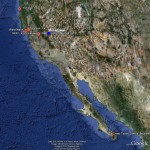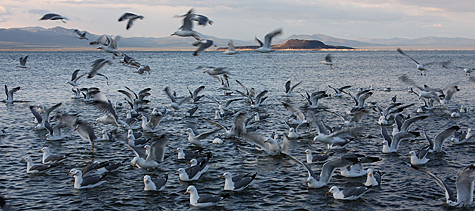
After 28 years of annual gull research on Mono Lake’s islands, you might wonder if there are any unanswered questions still out there. After reading PRBO’s 2010 report on the gull research (you can download the report here), the answer is clearly “yes”—and some of those questions were answered this year.
First, the results from the counts done every year. The 2010 California Gull population at Mono Lake was the second-lowest since 1983, and the number of chicks produced was the lowest ever recorded. The record cold spring weather and delayed hatch of brine shrimp likely contributed to the low nesting success. The researchers also noticed higher nest predation rates from other gulls than they had ever seen before, possibly due to lack of early season brine shrimp food.

Next, the new insights. Two hundred chicks were banded with colored bands this year. Six of those were found in coastal California locations in August and September. The locations ranged from the tip of Baja to Trinidad on California’s north coast, with most of the detections on the Farallon Islands west of San Francisco. The numbers of California Gulls at Southeast Farallon Island were greatly reduced from the previous year, possibly due to the low nesting success at Mono Lake.
California Gulls began nesting at San Francisco Bay in 1980, the same year that Mono Lake’s Negit Island colony was abandoned and a year after it was decimated by coyotes. During the last ten years, the nesting colonies at Mono Lake and San Francisco Bay have been negatively correlated, implying that the gulls assess the conditions at both locations before deciding where to nest. In 2010, 23,025 nests were counted at San Francisco Bay and only 18,186 at Mono. For two of the last three years Mono Lake has had a smaller gull population than San Francisco Bay. This is significant, because it means that Mono Lake is no longer the largest nesting colony of California Gulls in California. But this may be a temporary shift—in December, a San Francisco Bay levee was breached in Pond A6 where 23,000 gulls nested, restoring tidal action to the area. Due to the loss of this nesting area, we should expect Mono Lake’s gull numbers to be higher in 2011.
Lastly, a California Gull that was banded as a chick at Mono Lake in 1983 was spotted again nesting here in 2009. This makes it 26 years old—just two months short of being the longest living California Gull recorded through banding data. You can be sure the researchers will be keeping their eyes open for it when they return to Mono Lake’s islands this summer.


Wow, a 26-year-old gull. I spent several days in the summer of ’83 camped on the old movie set helping Dave Shuford band gulls – wonder if it was one of those! Thanks for interesting research update. Glad to hear the snowpack is looking good, too.
The photo you used at the top of the article is beautiful and exciting. Thanks for your excellant choice in editing for this page.
Yes, thanks for the update. I’m hoping your predicition that most of the San Francisco Bay’s displaced-from-Pond-A6 population will decide that the breeding habitat at Mono Lake is more desirable. Otherwise they may end up on the recently created artificial islands in Pond SF2 and nudging out the waterbirds that the islands were intended for or begin to increase their densities in the south San Francisco Bay’s Baumberg Ponds. What a complex and often intriguing system we have to steward. The monitoring and research efforts of organizations like PRBO Conservation Science are vital to our understanding and to any hope of a successful adaptive management approach.
Hey Bob,
Haven’t heard from you in years, glad you are still monitoring the MLC news.
Yes, the article was very interesting. Thanks, Greg.
Hey Sally, It’s a lot easier these days in the age of the web! Just saw that there’s an interesting seminar coming up on the public trust doctrine. Need to make it out there one of these days again. Looking forward to showing Mono Lake to my son.